Attractions · Europe · Featured · Food and Drink · France · Going Out · Regions · Travel Miscellany · Western Europe
Vineyards in Var: a tour of Domaine de l’Olivette
Covering an area of approximately 1,500 hectares, the terroir of the Bandol appellation covers 8 communes in Var (Bandol, Le Beausset, Le Castellet, La Cadière d’Azur, Saint Cyr-sur-mer, St. Anne of Evenos, Sanary-sur-mer and Ollioules) and some 50 winemakers. The region covers a natural amphitheatre of terraces that descend towards the Mediterranean Sea in the shelter of the Sainte Baume massif to the north.
During my stay at Mas du Brulat, a small luxury hotel in the commune of Le Castellet in the department of Var in Provence, I had the good fortune of visiting one of the many vineyards: the nearby Domaine de l’Olivette, producers of Bandol wines and suppliers to the hotel’s bar and restaurant.
 In fact, the domaine is one of the oldest in the Bandol appellation which was created back in 1941. Bandol is most famous for its red wines, which are characterised by the Mourvèdre grape – a grape variety which thrives in this hot region and gives the wine structure and tannins. Red wine makes up the majority of the appellation’s output and, to be a Bandol red, there must be at least 50% of the Mourvèdre grape in the blend. This is what gives the wine its structure.
At Domaine de l’Olivette, however, it’s the rosé wines that take centre stage. Enjoying views of both Le Castellet and La Cadière, the vineyard here has been under the loving protection of the same family for two centuries, preserving the local and typical characteristics of this wine, and today producing in the region of 250,000 bottles each year.
In fact, the domaine is one of the oldest in the Bandol appellation which was created back in 1941. Bandol is most famous for its red wines, which are characterised by the Mourvèdre grape – a grape variety which thrives in this hot region and gives the wine structure and tannins. Red wine makes up the majority of the appellation’s output and, to be a Bandol red, there must be at least 50% of the Mourvèdre grape in the blend. This is what gives the wine its structure.
At Domaine de l’Olivette, however, it’s the rosé wines that take centre stage. Enjoying views of both Le Castellet and La Cadière, the vineyard here has been under the loving protection of the same family for two centuries, preserving the local and typical characteristics of this wine, and today producing in the region of 250,000 bottles each year.
 At the time of our visit, the vines were looking a little bare but just starting to come into leaf. The yield at the vineyard is kept deliberately low at just under forty hectolitres per hectare – typically equating to one bottle of wine per vine. The lower the yield, the better the quality and concentration of the production, so the yield is limited for this very reason and regulations are in place to ensure this quality is maintained.
At the time of our visit, the vines were looking a little bare but just starting to come into leaf. The yield at the vineyard is kept deliberately low at just under forty hectolitres per hectare – typically equating to one bottle of wine per vine. The lower the yield, the better the quality and concentration of the production, so the yield is limited for this very reason and regulations are in place to ensure this quality is maintained.
 As you approach the heart of the domaine, it’s evident that the family also have a love of art, with many interesting pieces adorning the grounds before you reach the main entrance.
As you approach the heart of the domaine, it’s evident that the family also have a love of art, with many interesting pieces adorning the grounds before you reach the main entrance.
 Once inside, you are greeted by wine bottles of various sizes, yet more artwork, bottles made into a light fitting, a tasting area in one corner and even the head of a wild boar displayed in another.
Once inside, you are greeted by wine bottles of various sizes, yet more artwork, bottles made into a light fitting, a tasting area in one corner and even the head of a wild boar displayed in another.
 Of the 250,000 bottles produced on this vineyard, 75% is a rosé wine that blends Grenache with the old Mourvèdres, is light in colour, almost coral in complexion, with orangey reflections and a subtle blending of flowers and red berries. This refreshing rosé Domaine de l’Olivette has a fruity and titillating taste and draws its complexity from the aromatic subtleties of the Cinsault. It is a little spicy at the end which is typical of the Mourvèdre.
A further 20% is red wine that is 90% Mourvèdre, selected for its concentration and the finesse and richness of its tannins, and the remaining 5% of the vineyard’s production is a white wine with a beautiful, pale yellow colour and slightly green reflections.
Of the 250,000 bottles produced on this vineyard, 75% is a rosé wine that blends Grenache with the old Mourvèdres, is light in colour, almost coral in complexion, with orangey reflections and a subtle blending of flowers and red berries. This refreshing rosé Domaine de l’Olivette has a fruity and titillating taste and draws its complexity from the aromatic subtleties of the Cinsault. It is a little spicy at the end which is typical of the Mourvèdre.
A further 20% is red wine that is 90% Mourvèdre, selected for its concentration and the finesse and richness of its tannins, and the remaining 5% of the vineyard’s production is a white wine with a beautiful, pale yellow colour and slightly green reflections.
 Also on display in the ‘shop’ is a variety of local produce such as tapenades, with the same Domaine de L’Olivette branding. These can be purchased with bottles of wine in a variety of nicely-presented gift boxes.
Also on display in the ‘shop’ is a variety of local produce such as tapenades, with the same Domaine de L’Olivette branding. These can be purchased with bottles of wine in a variety of nicely-presented gift boxes.
 Round the back of this building, though, is where it all happens once the grapes have been hand-picked. If you get the opportunity to have a tour, make sure you take them up on it as it’ll give you an interesting insight into the lengths that the family go to in order to bring you AOC Bandol wines.
We were lucky enough to have a private tour with owner Jean-Luc Dumoutier who explained that initially they carry out a green harvest where they cut some good grapes, one month before the main harvest, to leave about half a dozen bunches per vine. This is to ensure quality, meaning that the goodness goes into few grapes.
Then, following the manual harvest, there is a meticulous double sorting to guarantee grapes of perfect quality. Hand picking ensures you get the best grapes from the harvest and then equipment is used as an aid to remove stalks, snails and so on. Nature also plays its part in the process in ways that might not be immediately obvious – the mistral winds in the area drive away the rain and and help to remove disease.
Round the back of this building, though, is where it all happens once the grapes have been hand-picked. If you get the opportunity to have a tour, make sure you take them up on it as it’ll give you an interesting insight into the lengths that the family go to in order to bring you AOC Bandol wines.
We were lucky enough to have a private tour with owner Jean-Luc Dumoutier who explained that initially they carry out a green harvest where they cut some good grapes, one month before the main harvest, to leave about half a dozen bunches per vine. This is to ensure quality, meaning that the goodness goes into few grapes.
Then, following the manual harvest, there is a meticulous double sorting to guarantee grapes of perfect quality. Hand picking ensures you get the best grapes from the harvest and then equipment is used as an aid to remove stalks, snails and so on. Nature also plays its part in the process in ways that might not be immediately obvious – the mistral winds in the area drive away the rain and and help to remove disease.
 The harvest starts with the Grenache in August. With the rosé, they are looking for ripe fruit; with the reds, they are looking for ripe tannins so need a couple more weeks. With that comes more sun – more sun and sugar means more alcohol, so the reads are generally one degree more in alcohol content, often 14-15%.
After sorting, they pass through machinery to lower the temperature. This prevents too much oxidation and stops fermenting happening too quickly too early. Machinery then pressurises the grapes but softly so the seeds are not crushed as that would give bitter taste, before going to tanks for vinification.
The harvest starts with the Grenache in August. With the rosé, they are looking for ripe fruit; with the reds, they are looking for ripe tannins so need a couple more weeks. With that comes more sun – more sun and sugar means more alcohol, so the reads are generally one degree more in alcohol content, often 14-15%.
After sorting, they pass through machinery to lower the temperature. This prevents too much oxidation and stops fermenting happening too quickly too early. Machinery then pressurises the grapes but softly so the seeds are not crushed as that would give bitter taste, before going to tanks for vinification.
 Two years ago, significant investment saw a major modernisation of the cellar with the installation of new equipment that is automatically temperature controlled. The temperature can get quite warm but had to be controlled at 18 degrees Centigrade for two weeks during fermentation. Carbonic gas, which can be quite dangerous, also has to be released. The rosé and white wines are made by the same process, but with the reds it is a little different.
Two years ago, significant investment saw a major modernisation of the cellar with the installation of new equipment that is automatically temperature controlled. The temperature can get quite warm but had to be controlled at 18 degrees Centigrade for two weeks during fermentation. Carbonic gas, which can be quite dangerous, also has to be released. The rosé and white wines are made by the same process, but with the reds it is a little different.
 Instead, with the reds they use a machine to pressurise the grapes – but softly so that the seeds are not crushed as that would give the wine a bitter taste. During the vinification process, everything then goes into the tank (with the rosé and white, it is just the juice) – this facilitates maceration and adds depth to the wine. The red wine then goes into large barrels that are more than 50 years old (once used by the now diminished beer industry in the area), remaining there for 18 to 24 months, depending on the profile of each wine, to allow a subtle ripening of tannins. This helps to develop reds of character – a powerful and racy blend of Mourvèdre and Grenache. The barrels have resin inside as wood traditionally had no place in the brewing of beer. The wood is porous to the air, though, so you get a micro-oxidisation that makes the tannins softer.
Instead, with the reds they use a machine to pressurise the grapes – but softly so that the seeds are not crushed as that would give the wine a bitter taste. During the vinification process, everything then goes into the tank (with the rosé and white, it is just the juice) – this facilitates maceration and adds depth to the wine. The red wine then goes into large barrels that are more than 50 years old (once used by the now diminished beer industry in the area), remaining there for 18 to 24 months, depending on the profile of each wine, to allow a subtle ripening of tannins. This helps to develop reds of character – a powerful and racy blend of Mourvèdre and Grenache. The barrels have resin inside as wood traditionally had no place in the brewing of beer. The wood is porous to the air, though, so you get a micro-oxidisation that makes the tannins softer.
 From the point of concept, through to planting, growing and harvesting the vines, you can easily be looking at 20 years for the production of a quality Bandol red. For a cuvée speciale, you are looking at a minimum of 25 years. The domaine is currently selling their 2014-2015 vintage – the tannins are still there but become softer with age, and it’s this evolution of old leather that is typical of Mourvèdre and what is so typical of a Bandol red wine. This would go well with something like magret de canard (duck breast) or lamb or a wild boar stew.
The red is better if kept longer whereas with the 2014 rosé there has been more evolution of the wine – this vintage is very exclusive and would go nicely with foie gras. The anti-oxidisation qualities of Mourvèdre grape are key, since oxidisation is the enemy when it comes to being able to keep the wine a long time. The same is not true of the white which does not contain the Mourvèdre grape – it’s Claret and Rolle mainly.
From the point of concept, through to planting, growing and harvesting the vines, you can easily be looking at 20 years for the production of a quality Bandol red. For a cuvée speciale, you are looking at a minimum of 25 years. The domaine is currently selling their 2014-2015 vintage – the tannins are still there but become softer with age, and it’s this evolution of old leather that is typical of Mourvèdre and what is so typical of a Bandol red wine. This would go well with something like magret de canard (duck breast) or lamb or a wild boar stew.
The red is better if kept longer whereas with the 2014 rosé there has been more evolution of the wine – this vintage is very exclusive and would go nicely with foie gras. The anti-oxidisation qualities of Mourvèdre grape are key, since oxidisation is the enemy when it comes to being able to keep the wine a long time. The same is not true of the white which does not contain the Mourvèdre grape – it’s Claret and Rolle mainly.
 In order to be accepted as a Bandol wine, it must pass on two criteria in a blind tasting carried out by around seven people, much like an examination. Firstly, is it good enough? And secondly, is it typical enough?
In Bandol itself, you can visit Les Vins de Bandol where you can purchase many different wines from around the area, receive advice or learn about a variety of Bandol-related events.
In order to be accepted as a Bandol wine, it must pass on two criteria in a blind tasting carried out by around seven people, much like an examination. Firstly, is it good enough? And secondly, is it typical enough?
In Bandol itself, you can visit Les Vins de Bandol where you can purchase many different wines from around the area, receive advice or learn about a variety of Bandol-related events.

 You can also pick up information about Bandol Wine Tours where you can explore, discover and experience the best of the Bandol wine domaines. Full day wine tours including a gastronomic lunch on a vineyard start from €159 per person whilst full day wine tours with foie gras and a wine picnic start from €139.
Disclosure: Our trip to the South of France was courtesy of Mas du Brulat, a small luxury hotel in Le Castellet commune of Provence – part of the Olives & Vines brand.
You can also pick up information about Bandol Wine Tours where you can explore, discover and experience the best of the Bandol wine domaines. Full day wine tours including a gastronomic lunch on a vineyard start from €159 per person whilst full day wine tours with foie gras and a wine picnic start from €139.
Disclosure: Our trip to the South of France was courtesy of Mas du Brulat, a small luxury hotel in Le Castellet commune of Provence – part of the Olives & Vines brand.
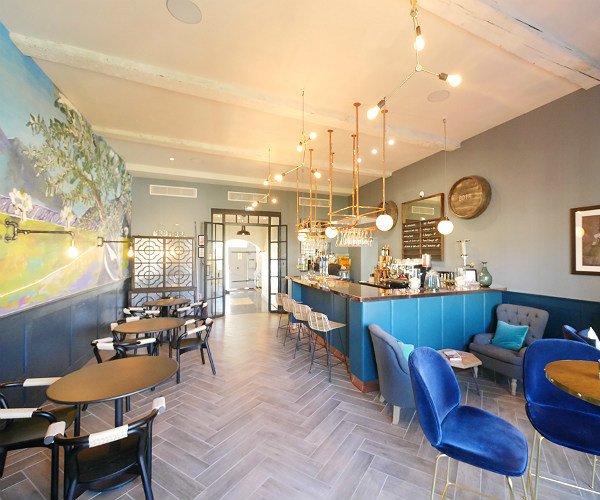 In fact, the domaine is one of the oldest in the Bandol appellation which was created back in 1941. Bandol is most famous for its red wines, which are characterised by the Mourvèdre grape – a grape variety which thrives in this hot region and gives the wine structure and tannins. Red wine makes up the majority of the appellation’s output and, to be a Bandol red, there must be at least 50% of the Mourvèdre grape in the blend. This is what gives the wine its structure.
At Domaine de l’Olivette, however, it’s the rosé wines that take centre stage. Enjoying views of both Le Castellet and La Cadière, the vineyard here has been under the loving protection of the same family for two centuries, preserving the local and typical characteristics of this wine, and today producing in the region of 250,000 bottles each year.
In fact, the domaine is one of the oldest in the Bandol appellation which was created back in 1941. Bandol is most famous for its red wines, which are characterised by the Mourvèdre grape – a grape variety which thrives in this hot region and gives the wine structure and tannins. Red wine makes up the majority of the appellation’s output and, to be a Bandol red, there must be at least 50% of the Mourvèdre grape in the blend. This is what gives the wine its structure.
At Domaine de l’Olivette, however, it’s the rosé wines that take centre stage. Enjoying views of both Le Castellet and La Cadière, the vineyard here has been under the loving protection of the same family for two centuries, preserving the local and typical characteristics of this wine, and today producing in the region of 250,000 bottles each year.
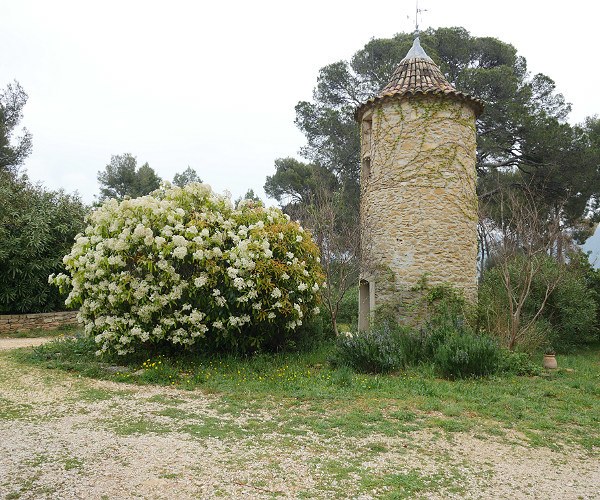 At the time of our visit, the vines were looking a little bare but just starting to come into leaf. The yield at the vineyard is kept deliberately low at just under forty hectolitres per hectare – typically equating to one bottle of wine per vine. The lower the yield, the better the quality and concentration of the production, so the yield is limited for this very reason and regulations are in place to ensure this quality is maintained.
At the time of our visit, the vines were looking a little bare but just starting to come into leaf. The yield at the vineyard is kept deliberately low at just under forty hectolitres per hectare – typically equating to one bottle of wine per vine. The lower the yield, the better the quality and concentration of the production, so the yield is limited for this very reason and regulations are in place to ensure this quality is maintained.
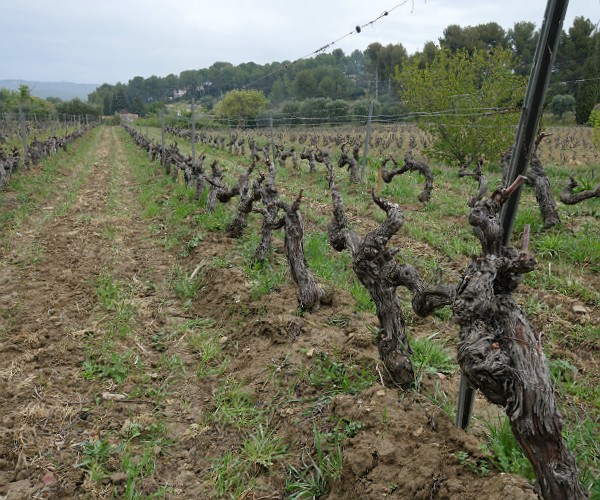 As you approach the heart of the domaine, it’s evident that the family also have a love of art, with many interesting pieces adorning the grounds before you reach the main entrance.
As you approach the heart of the domaine, it’s evident that the family also have a love of art, with many interesting pieces adorning the grounds before you reach the main entrance.
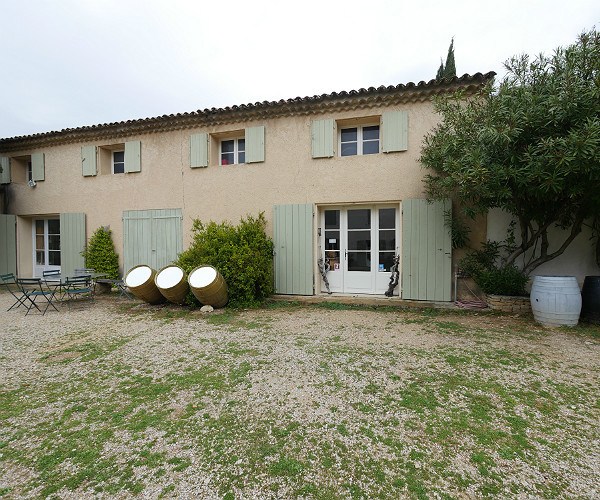 Once inside, you are greeted by wine bottles of various sizes, yet more artwork, bottles made into a light fitting, a tasting area in one corner and even the head of a wild boar displayed in another.
Once inside, you are greeted by wine bottles of various sizes, yet more artwork, bottles made into a light fitting, a tasting area in one corner and even the head of a wild boar displayed in another.
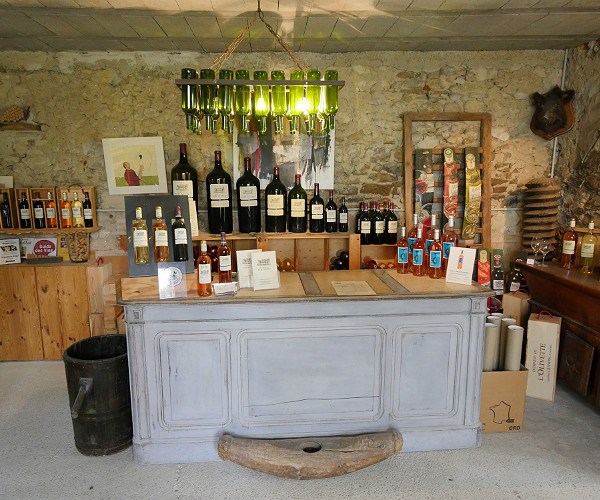 Of the 250,000 bottles produced on this vineyard, 75% is a rosé wine that blends Grenache with the old Mourvèdres, is light in colour, almost coral in complexion, with orangey reflections and a subtle blending of flowers and red berries. This refreshing rosé Domaine de l’Olivette has a fruity and titillating taste and draws its complexity from the aromatic subtleties of the Cinsault. It is a little spicy at the end which is typical of the Mourvèdre.
A further 20% is red wine that is 90% Mourvèdre, selected for its concentration and the finesse and richness of its tannins, and the remaining 5% of the vineyard’s production is a white wine with a beautiful, pale yellow colour and slightly green reflections.
Of the 250,000 bottles produced on this vineyard, 75% is a rosé wine that blends Grenache with the old Mourvèdres, is light in colour, almost coral in complexion, with orangey reflections and a subtle blending of flowers and red berries. This refreshing rosé Domaine de l’Olivette has a fruity and titillating taste and draws its complexity from the aromatic subtleties of the Cinsault. It is a little spicy at the end which is typical of the Mourvèdre.
A further 20% is red wine that is 90% Mourvèdre, selected for its concentration and the finesse and richness of its tannins, and the remaining 5% of the vineyard’s production is a white wine with a beautiful, pale yellow colour and slightly green reflections.
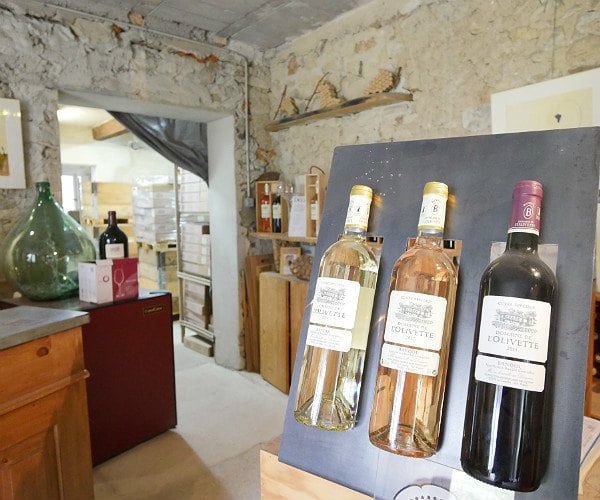 Also on display in the ‘shop’ is a variety of local produce such as tapenades, with the same Domaine de L’Olivette branding. These can be purchased with bottles of wine in a variety of nicely-presented gift boxes.
Also on display in the ‘shop’ is a variety of local produce such as tapenades, with the same Domaine de L’Olivette branding. These can be purchased with bottles of wine in a variety of nicely-presented gift boxes.
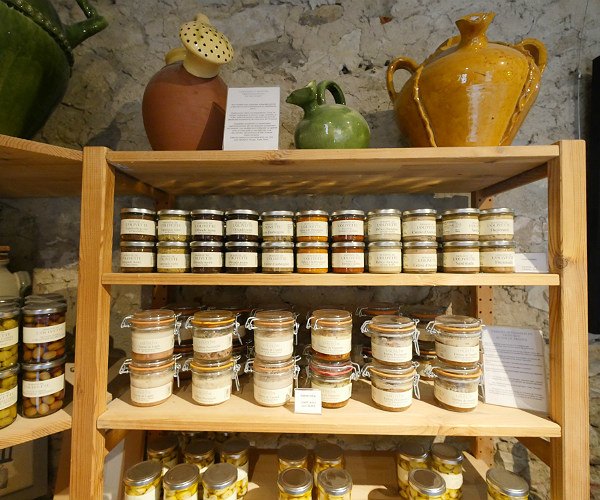 Round the back of this building, though, is where it all happens once the grapes have been hand-picked. If you get the opportunity to have a tour, make sure you take them up on it as it’ll give you an interesting insight into the lengths that the family go to in order to bring you AOC Bandol wines.
We were lucky enough to have a private tour with owner Jean-Luc Dumoutier who explained that initially they carry out a green harvest where they cut some good grapes, one month before the main harvest, to leave about half a dozen bunches per vine. This is to ensure quality, meaning that the goodness goes into few grapes.
Then, following the manual harvest, there is a meticulous double sorting to guarantee grapes of perfect quality. Hand picking ensures you get the best grapes from the harvest and then equipment is used as an aid to remove stalks, snails and so on. Nature also plays its part in the process in ways that might not be immediately obvious – the mistral winds in the area drive away the rain and and help to remove disease.
Round the back of this building, though, is where it all happens once the grapes have been hand-picked. If you get the opportunity to have a tour, make sure you take them up on it as it’ll give you an interesting insight into the lengths that the family go to in order to bring you AOC Bandol wines.
We were lucky enough to have a private tour with owner Jean-Luc Dumoutier who explained that initially they carry out a green harvest where they cut some good grapes, one month before the main harvest, to leave about half a dozen bunches per vine. This is to ensure quality, meaning that the goodness goes into few grapes.
Then, following the manual harvest, there is a meticulous double sorting to guarantee grapes of perfect quality. Hand picking ensures you get the best grapes from the harvest and then equipment is used as an aid to remove stalks, snails and so on. Nature also plays its part in the process in ways that might not be immediately obvious – the mistral winds in the area drive away the rain and and help to remove disease.
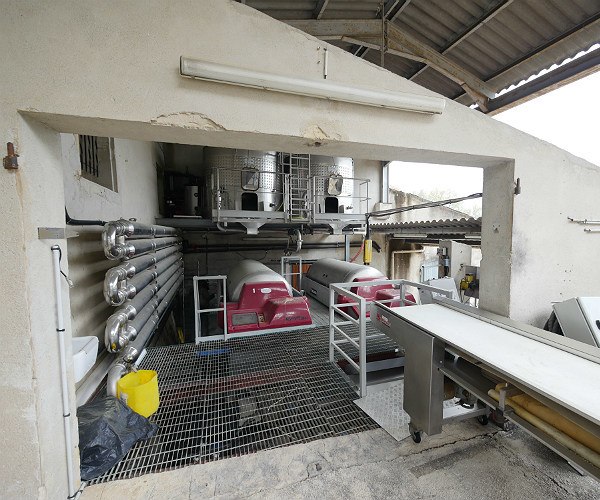 The harvest starts with the Grenache in August. With the rosé, they are looking for ripe fruit; with the reds, they are looking for ripe tannins so need a couple more weeks. With that comes more sun – more sun and sugar means more alcohol, so the reads are generally one degree more in alcohol content, often 14-15%.
After sorting, they pass through machinery to lower the temperature. This prevents too much oxidation and stops fermenting happening too quickly too early. Machinery then pressurises the grapes but softly so the seeds are not crushed as that would give bitter taste, before going to tanks for vinification.
The harvest starts with the Grenache in August. With the rosé, they are looking for ripe fruit; with the reds, they are looking for ripe tannins so need a couple more weeks. With that comes more sun – more sun and sugar means more alcohol, so the reads are generally one degree more in alcohol content, often 14-15%.
After sorting, they pass through machinery to lower the temperature. This prevents too much oxidation and stops fermenting happening too quickly too early. Machinery then pressurises the grapes but softly so the seeds are not crushed as that would give bitter taste, before going to tanks for vinification.
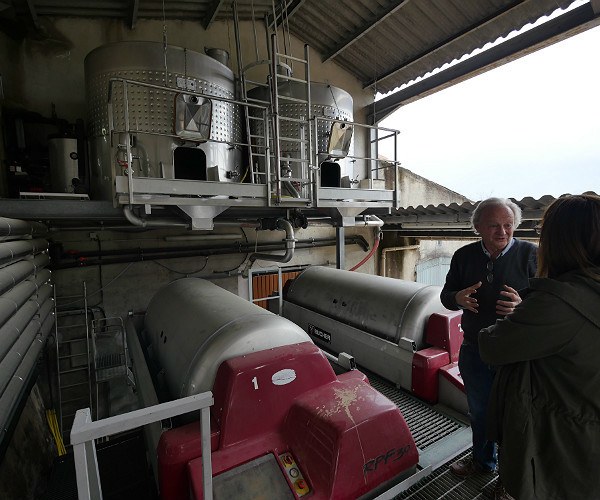 Two years ago, significant investment saw a major modernisation of the cellar with the installation of new equipment that is automatically temperature controlled. The temperature can get quite warm but had to be controlled at 18 degrees Centigrade for two weeks during fermentation. Carbonic gas, which can be quite dangerous, also has to be released. The rosé and white wines are made by the same process, but with the reds it is a little different.
Two years ago, significant investment saw a major modernisation of the cellar with the installation of new equipment that is automatically temperature controlled. The temperature can get quite warm but had to be controlled at 18 degrees Centigrade for two weeks during fermentation. Carbonic gas, which can be quite dangerous, also has to be released. The rosé and white wines are made by the same process, but with the reds it is a little different.
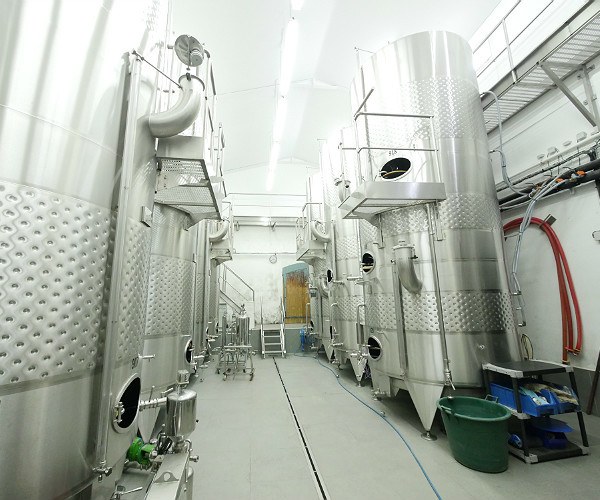 Instead, with the reds they use a machine to pressurise the grapes – but softly so that the seeds are not crushed as that would give the wine a bitter taste. During the vinification process, everything then goes into the tank (with the rosé and white, it is just the juice) – this facilitates maceration and adds depth to the wine. The red wine then goes into large barrels that are more than 50 years old (once used by the now diminished beer industry in the area), remaining there for 18 to 24 months, depending on the profile of each wine, to allow a subtle ripening of tannins. This helps to develop reds of character – a powerful and racy blend of Mourvèdre and Grenache. The barrels have resin inside as wood traditionally had no place in the brewing of beer. The wood is porous to the air, though, so you get a micro-oxidisation that makes the tannins softer.
Instead, with the reds they use a machine to pressurise the grapes – but softly so that the seeds are not crushed as that would give the wine a bitter taste. During the vinification process, everything then goes into the tank (with the rosé and white, it is just the juice) – this facilitates maceration and adds depth to the wine. The red wine then goes into large barrels that are more than 50 years old (once used by the now diminished beer industry in the area), remaining there for 18 to 24 months, depending on the profile of each wine, to allow a subtle ripening of tannins. This helps to develop reds of character – a powerful and racy blend of Mourvèdre and Grenache. The barrels have resin inside as wood traditionally had no place in the brewing of beer. The wood is porous to the air, though, so you get a micro-oxidisation that makes the tannins softer.
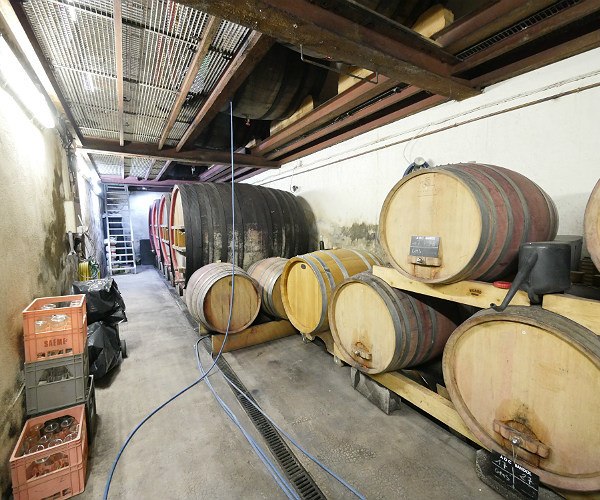 From the point of concept, through to planting, growing and harvesting the vines, you can easily be looking at 20 years for the production of a quality Bandol red. For a cuvée speciale, you are looking at a minimum of 25 years. The domaine is currently selling their 2014-2015 vintage – the tannins are still there but become softer with age, and it’s this evolution of old leather that is typical of Mourvèdre and what is so typical of a Bandol red wine. This would go well with something like magret de canard (duck breast) or lamb or a wild boar stew.
The red is better if kept longer whereas with the 2014 rosé there has been more evolution of the wine – this vintage is very exclusive and would go nicely with foie gras. The anti-oxidisation qualities of Mourvèdre grape are key, since oxidisation is the enemy when it comes to being able to keep the wine a long time. The same is not true of the white which does not contain the Mourvèdre grape – it’s Claret and Rolle mainly.
From the point of concept, through to planting, growing and harvesting the vines, you can easily be looking at 20 years for the production of a quality Bandol red. For a cuvée speciale, you are looking at a minimum of 25 years. The domaine is currently selling their 2014-2015 vintage – the tannins are still there but become softer with age, and it’s this evolution of old leather that is typical of Mourvèdre and what is so typical of a Bandol red wine. This would go well with something like magret de canard (duck breast) or lamb or a wild boar stew.
The red is better if kept longer whereas with the 2014 rosé there has been more evolution of the wine – this vintage is very exclusive and would go nicely with foie gras. The anti-oxidisation qualities of Mourvèdre grape are key, since oxidisation is the enemy when it comes to being able to keep the wine a long time. The same is not true of the white which does not contain the Mourvèdre grape – it’s Claret and Rolle mainly.
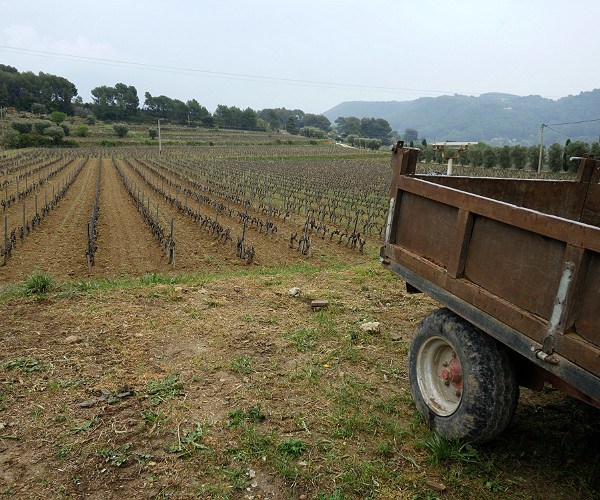 In order to be accepted as a Bandol wine, it must pass on two criteria in a blind tasting carried out by around seven people, much like an examination. Firstly, is it good enough? And secondly, is it typical enough?
In Bandol itself, you can visit Les Vins de Bandol where you can purchase many different wines from around the area, receive advice or learn about a variety of Bandol-related events.
In order to be accepted as a Bandol wine, it must pass on two criteria in a blind tasting carried out by around seven people, much like an examination. Firstly, is it good enough? And secondly, is it typical enough?
In Bandol itself, you can visit Les Vins de Bandol where you can purchase many different wines from around the area, receive advice or learn about a variety of Bandol-related events.
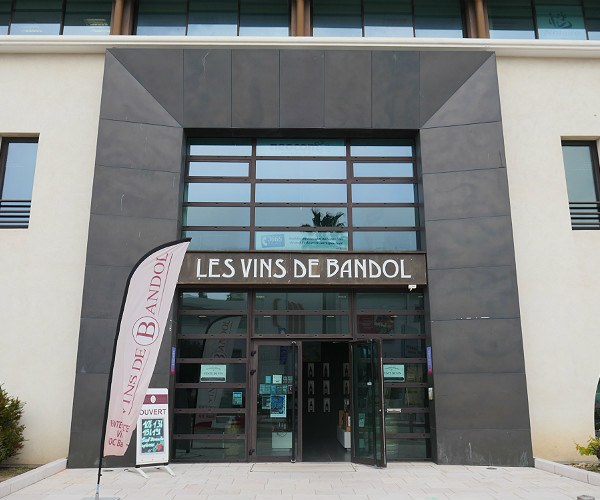
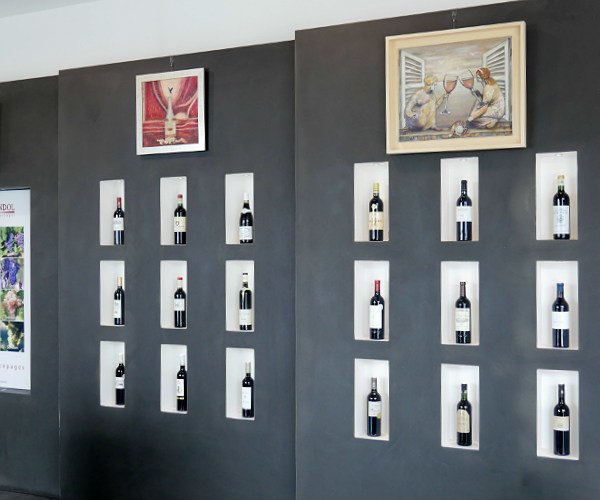 You can also pick up information about Bandol Wine Tours where you can explore, discover and experience the best of the Bandol wine domaines. Full day wine tours including a gastronomic lunch on a vineyard start from €159 per person whilst full day wine tours with foie gras and a wine picnic start from €139.
Disclosure: Our trip to the South of France was courtesy of Mas du Brulat, a small luxury hotel in Le Castellet commune of Provence – part of the Olives & Vines brand.
You can also pick up information about Bandol Wine Tours where you can explore, discover and experience the best of the Bandol wine domaines. Full day wine tours including a gastronomic lunch on a vineyard start from €159 per person whilst full day wine tours with foie gras and a wine picnic start from €139.
Disclosure: Our trip to the South of France was courtesy of Mas du Brulat, a small luxury hotel in Le Castellet commune of Provence – part of the Olives & Vines brand.Did you enjoy this article?
Receive similar content direct to your inbox.


It seems such an interesting and stylish place. It seems like a small paradise for all wine lovers.
I have visited a few vineyards and been given tours. I’ve always held the winemakers in great regard as it is such a skilled job. There’s just so much care and preparation. Firstly you they have to keep the vines in tip-top condition then, in some ways, the winemaker’s work really begins once the harvest comes in.
I just don’t think that I have got the nerves of steel that it takes to create a top-notch vintage. First of all you’ve got to pray that there aren’t any late frosts getting at the young leaves In early summer you want sunshine and showers, but it can’t be too hot. And you certainly don’t want storms ravaging the vines. Then finally you want a dry autumn to get the harvest in. I just couldn’t cope with all the stress.
My wife is a huge fan of rosé wine, in fact it is very rare that she sips a white or a red. The combination that blends Grenache with the Mourvedres sounds aa if it would be right up her street.
Fo any of those quarter of a million Domaine de l’Olivette bottles ever get exported to the U.K. And if so where can I purchase some?
I’m sorry, I’m really not sure about that. I’ll alert the owner to this query and see if I can find out for you…
I enjoy my wines, particularly a good red, but I am in complete awe of the people who know what they are talking about and can make pronouncements about “hints of black currants” or very “plummy”. Though I love visiting vineyards and trying to pick-up a little wine lore from the professionals
Yes. It would be great to have that talent with wines but it does come at a price. You really have to wrap your senses in cotton wool. No spicy foods. No after-shave or perfumes. No smoking either. If you get a cold or sore throat it can stop you working for ages.
Intriguing point about the quality of the art work on display. I’ve noticed that at other vineyards too. Perhaps it goes with the territory. The creativity of winemaking coming across in the creativity of the displays.
Var is such a fantastic wine-growing region! I’m not familiar with this vineyard specifically but will definitely look it up when I’m next in the area… plus the hotel!!